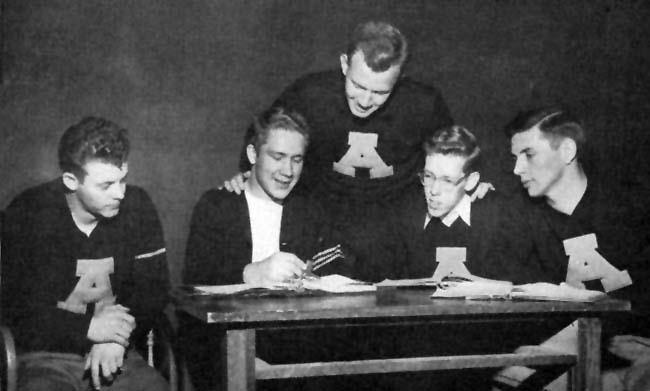Tribe of Vikings since 1927

In the 1920s, one of Augustana’s most popular student groups was the Letterman’s A Club, made up of men who had earned a varsity letter in a sport. On March 28, 1927, the Lettermen’s A Club led by “Hooty” Thorson ’28 unanimously voted to change the name of the organization to Tribe of Vikings. Membership dues were $1.
“It was a big deal to be in the Tribe of Vikings,” said Dave Wrath ’80, Augustana sports information director. “The most popular guys on campus were part of it.”
Their mission? To foster a growing spirit of brotherhood among the athletes, to sponsor and encourage athletic activities, and to advocate good and clean sportsmanship, according to a 1927 Augustana Observer article. (Women were honored for their athletic achievements with membership in the Valkyries, organized in 1928.)
From the beginning, the Tribe of Vikings worked to raise money for the college’s athletics program and fire up school spirit. The group sponsored basketball tournaments and high school track meets, basketball games with faculty riding donkeys, all-school skating parties and hayrack rides. The group also handled concessions at athletic events and held Christmas parties for underprivileged children in Rock Island.
But the Tribe of Vikings’ status on campus waned during the early 1940s, mainly due to the war.
In February 1947, the Observer ran an article headlined: The Tribe’s Back! It noted the Tribe of Vikings’ position of prestige and power before a lapse during the war years “during which no such organization was needed.”

The student newspaper’s editors supported a rebirth of the Tribe of Vikings, mainly to recruit high school athletes: “Many prep school stars who should come to Augustana either by virtue or the proximity of their homes to Augie or for denominational reasons are lost to the school because they are shown more attention by fraternities or clubs of other colleges.”
Interest in the Tribe of Vikings depended on the year but overall, it was an important student organization for more than three decades. That started to change in the late 1960s, when the atmosphere on campuses across the nation became oriented toward social justice and politics. College students became more active in the issues of the day. The 1969 Rockety-I is the last yearbook that devoted at least a page to the Tribe of Vikings.
“What happened to the Tribe of Vikings was similar to what happened to other clubs on our campus and campuses everywhere. Activism was huge in the 1960s, and then apathy was a problem in the 1970s. By 1976, Tribe of Vikings didn’t exist as a viable club,” said Wrath, who was a first-year student in 1976.
A breakfast for Tribe of Vikings alumni before the Homecoming game, however, continued through the 1980s.
“Through the years, the Tribe of Vikings has been there to support the college’s athletics programs and the student-athletes—that remains the same today.” – Kyle Ekberg ’09, athletics gift officer
Also in the 1980s, the college’s Sports Information Office revived the Tribe of Vikings newsletter that listed game results and stats for every varsity team. The cost was $25/year to receive the newsletter.
Money raised from the newsletter and generous donors built a Tribe of Vikings Fund to support student-athletes, facility improvements, operational needs and new equipment. Through the years, scoreboards, a scorer’s table, flags, pennants, tarps for the baseball and softball fields, and a sound system for the softball field were purchased with Tribe of Vikings dollars.
Today, Augustana’s athletics gift officer, Kyle Ekberg ’09, is focused on raising Tribe of Vikings funds to support the student-athlete experience, as well as planning events and competitions, such as the Homecoming Dome Dash, and organizing a network of former athletes interested in helping students with internships and jobs.
“Through the years, the Tribe of Vikings has been there to support the college’s athletics programs and the student-athletes — that remains the same today,” Ekberg said. “It’s a tremendous group of people who are looking for ways to help the Vikings stay successful on and off the field.”
For more information, contact David DeSimone.
